If you’re one of the 80% of adults who suffer from back pain at some point in their lives, you know how debilitating it can be.
In the morning, back pain can make it difficult to get out of bed. It can also prevent you from playing with your kids.
The good news is that back strengthening exercises can reduce back pain and prevent future injuries. Strong back muscles provide essential support for your spine, improving posture and stability.
In this post, we’ll tell you the top 10 exercises to strengthen your back from physical therapists and fitness experts.
These exercises can be done at home with little equipment, so you can easily add them to your weekly workout routine. They target all the major muscle groups including the lower back, middle back, and upper back.
With consistency, you’ll stand taller, feel less pain, and have more freedom to do activities you love.
Let’s get started!

- What Is the Importance Of a Strong Back?
- Workout That You Need To Strengthen Your Back
- 1. Flexibility-Based Workout
- 2. Strength-Based Workout
- Best Exercises to Strengthen Your Lower Back
- 1. Bridge Pose
- 2. Plank
- 3. Dead Bug
- 4. Bird Dog
- 5. Good Morning
- Exercises for Upper Back Strength
- 6. Pull-Up
- 7. Resistance Bands Lats Pulldown
- 8. Resistance Band Pull Apart
- 9. One Arm Dumbbell Row
- 10. Renegade Row
- 11. Dumbbell Deadlift
- Exercises To Improve Back Flexibility and Strength
- 12. Cat Cow
- 13. Knee to Chest
- 14. Lying Bent-Knee Twist
- 15. Abdominal Breathing Maneuver
- Benefits of the Back Workout
- Conclusion
- References
What Is the Importance Of a Strong Back?
According to the American Association of Neurological Surgeons, 75 to 85 percent of Americans will experience back pain during their lifetime. Over 50 percent of those people will have more than one episode in a year.
From basic movement to lifting heavy weights, you require the full support of your spine and back, so you can move effortlessly. Since we live a very passive lifestyle, many of us with desk jobs have poor posture and weak muscles.
Also, when we bend our shoulders to look at our devices, our upper body adjusts to sitting. Eventually, this causes us to lose flexibility in our upper back region, which worsens with time.
Eventually, you will notice that with every movement, the body will be very stiff making you struggle with the movement and eventually, this will cause back pain.

A few years ago, back pain was only associated with old age, but now people as young as 25 are reporting back pain.
Experts think that back pain not just about how we live and what we eat, but also about working out more.
Since flexibility is one of the biggest issues so far. You have to intentionally align your workout with simple exercises that can help you not only work on your posture and flexibility, but also help you strengthen your back muscles.
With the help of this article, we will look at some of the main benefits you need to exercise for your back.
We will then look at the types of exercise that you can try and their impact on the body.
Workout That You Need To Strengthen Your Back
You should know that every workout you choose has a very specific purpose and has a different impact on your body.
Some workouts just help you support your body, while others will help you challenge the limits of your body.
When it comes to your back, you’ll find people suggesting various workouts, but you have to pick what works best for you.
Finally, we will look at some of the easier and simplest back workouts that you can try to strengthen and have flexibility in your back.
1. Flexibility-Based Workout
For a healthy back, flexibility is just as important as strength. Flexibility workouts go beyond simple stretching to increase range of motion and prepare muscles for action. These exercises improve spinal flexibility and mobility.
Dynamic stretches like the Cat-Cow promote spinal mobility and rotation to loosen the upper and lower back.
These exercises improve the ease of movement for daily activities like bending and twisting.
2. Strength-Based Workout
A strong back is important for everyone, not just fitness enthusiasts. It helps you do daily tasks without feeling pain or tired.
Strength workouts work on the muscles that support the spine to make you stronger and more able to deal with any physical challenge.
You not only become stronger, but also have better mobility and capacity to manage loads like groceries, children, or furniture. And leads to better posture, less pain, and more confidence to live an active lifestyle.
These workouts include exercises like deadlifts, pull-ups, and rowing.
Best Exercises to Strengthen Your Lower Back
All of these exercises should be performed slowly and with control to avoid injury.
When performing strengthening and flexibility exercises, make sure to breathe naturally and without holding your breath; exhale during exertion and inhale during relaxation.
1. Bridge Pose
This workout is perfect for targeting the gluteus and the abdominal muscles. It will help you strengthen your back much more easily.
It is a good starter move for butt, hamstring, and low back muscles and the best back exercises at home for managing chronic low back pain. It is one of the valuable glute and core strengthening exercises.
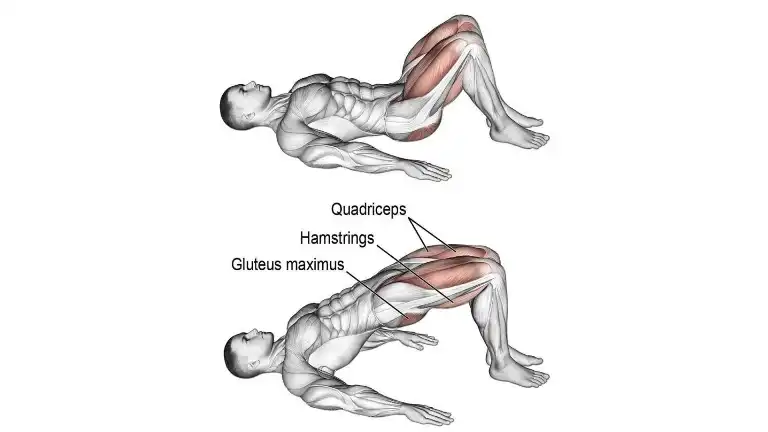
How To Do Bridge Pose
- Lie face up on the floor, with your knees bent and feet flat on the ground.
- Keep your arms at your side with your palms down.
- Lift your hips off the ground until your knees, hips, and shoulders form a straight line.
- Squeeze those glutes hard and keep your abs drawn in, so you don’t overextend your back during the exercise.
- Hold your bridged position for a couple of seconds before keeping back down.
2. Plank
The plank is a brilliant bodyweight exercise that helps you to develop the strength and stability of your core. Your muscles are exercised isometrically. Perfect for the upper back, lower back, abs, and hip area.
The most common plank is the forearm plank, which is held in a push-up-like position, with the body’s weight borne on forearms, elbows, and toes.
The side plank is a great exercise for strengthening the oblique and abs muscles. Strong obliques can be very useful as spine stabilization muscles.
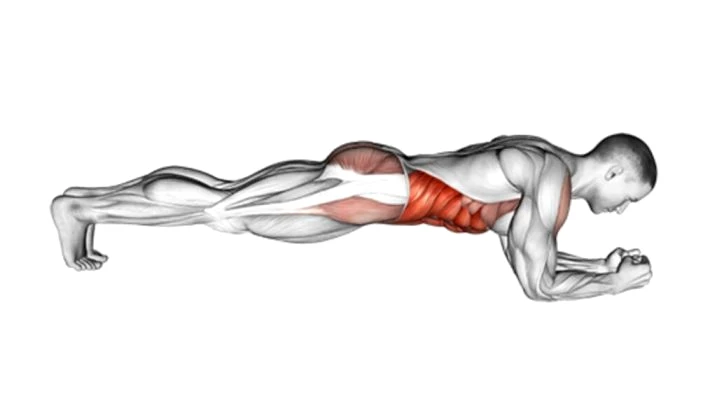
How To Do Plank
- You need to start by laying on your time and then get into the push-up position.
- Once you reach that phase, you have to hold this pose while making sure your back is straight, and you are keeping your abs tight.
- Hold this position for a set amount of time.
- Then do 3-4 more sets.
3. Dead Bug
The dead bug exercise is a popular way to build core strength and stabilization. It helps build a solid, stable foundation that protects the spine and allows for greater ease in every day and athletic movements, such as moving heavy objects, walking up hills, and throwing.
This move also helps prevent and relieve back pain by protecting your lower back.
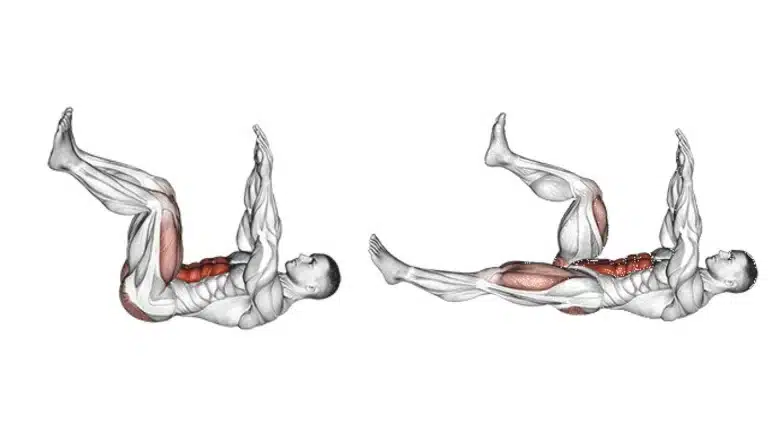
How To Do Dead Bug
- Lie face up with your arms extended toward the ceiling and your legs in a tabletop position.
- Slowly extend your right leg out straight, and simultaneously your left arm overhead.
- Squeeze your butt and keep your core engaged the entire time, lower back pressed into the floor.
- Bring your arm and leg back to the starting position.
- Repeat on the other side, extending your left leg and your right arm.
4. Bird Dog
The bird-dog exercise that strengthens the core—more specifically, the abdominal, oblique muscles, lower back, butt, and thighs.
The bird dog is one of the best core exercises that looks elegant and is also very effective for training the abdominal muscles, oblique and back.
Several other muscles are also addressed, including the glutes.

How To Do Bird Dog
- Get on your knees and place your hands on the floor in front of your body at shoulder width.
- Keep your spine in a neutral position and contract your abs and lift one hand and the opposite knee slightly off the floor.
- Now extend your arm and leg all the way out. Try to form a straight plane from your hand to your foot.
- Hold this position for about 10 seconds and then return to the starting position. Repeat the exercise with the other side. Repeat the exercise alternately.
5. Good Morning
It is known as a good morning because of the movement in the erector spinae which resembles the rise out of bed to stretch.
The erector spinae muscles of the lower back work isometrically to keep the spine in an extended position, while the hamstrings and gluteus maximus work isotonically to perform hip extension.
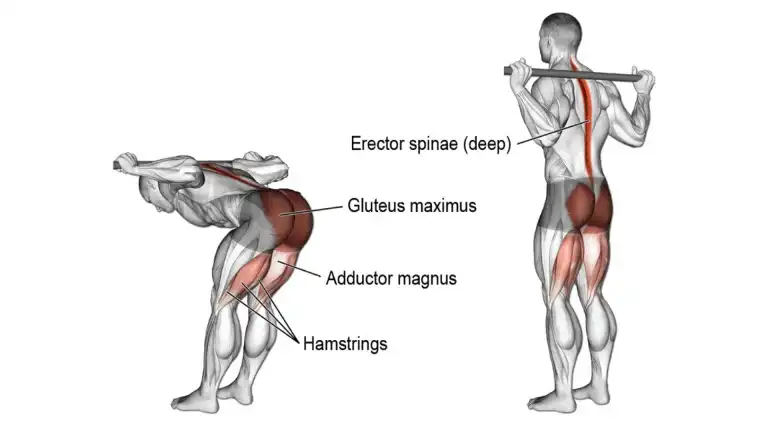
How To Do Good Morning
- Stand holding a Stick on the back of your shoulders, grasping the Stick at each side.
- You can also perform the exercise as in the bodyweight version.
- Keep your knees slightly flexed and your back and neck neutral.
- Inhale as you flex your hips to lower your torso until it is close to or fully horizontal.
- Exhale as you raise your torso back up to the starting position by extending your hips.
Exercises for Upper Back Strength
6. Pull-Up
The pull-up is an upper-body strength movement that targets your back, chest, shoulders, and arms. They are often a challenge for beginners and even experienced athletes to perform.
The pull-up increases the strength, thickness, and width of your back, specifically your lats.
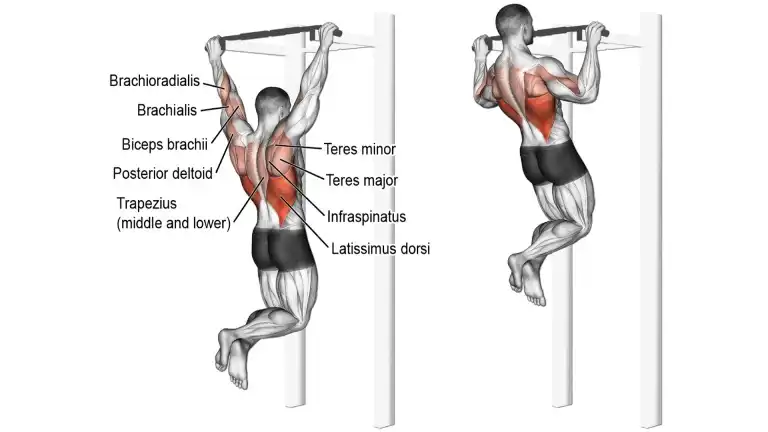
How To Do Pull-Up
- Using an overhand grip, grab a pull-up bar with your hands positioned at shoulder-width apart.
- Hang from the bar with your arms fully extended and your chest high, while exaggerating the arch in your lower back.
- Pull yourself up by squeezing your shoulder blades together and contracting your lats until your chin passes the bar.
- Hold the contraction at the top for a second before slowly lowering yourself back to the starting position.
7. Resistance Bands Lats Pulldown
The resistance band lats pulldown can be done anywhere, so it’s a good option for home workouts or while travelling.
It is a compound exercise that engages multiple muscle groups of the back, specifically the latissimus dorsi (lats) and teres major.

How To Do Band Lat Pulldown
- Attach the resistance band to a sturdy anchor point above your head, such as a door frame.
- Stand facing the anchor point and grasp the resistance band with an overhand grip.
- Step back to create tension in the band. Engage your core, slightly lean back.
- Pull the band down towards your chest. Squeeze your shoulder blades together at the end of the movement.
- Slowly release the tension and return to the starting position.
- Repeat for the desired number of repetitions.
8. Resistance Band Pull Apart
The bands pull apart is a great shoulder and upper back exercise. It’s work your rhomboids, rear delts, and traps.
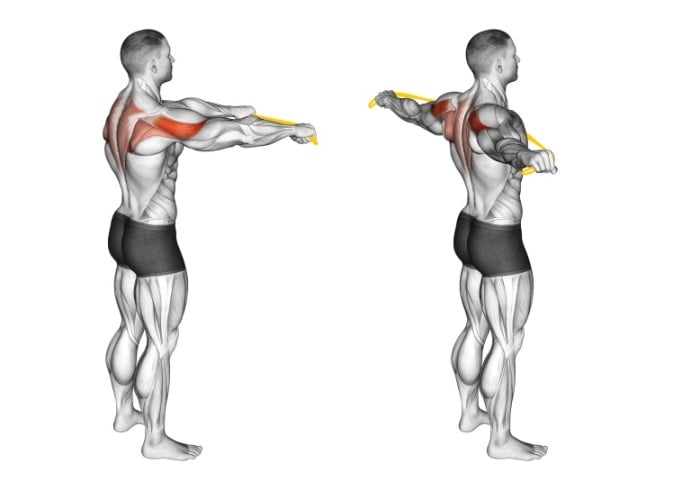
How To Do
- Stand with your feet shoulder-width apart.
- Hold the exercise band in front of you with your hands a little lower than your shoulders.
- Squeeze the shoulder blades together and open the arms out to either side, pulling the band apart and squeezing your rhomboids.
- Return to start and repeat, keeping tension on the band the entire time.
- Repeat the desired number of reps.
9. One Arm Dumbbell Row
One arm dumbbell rows are a strength exercise that works your back muscles, specifically targeting your lats, rhomboids, and traps.
This exercise can be done with a single dumbbell that helps to work on each side independently, thereby providing better muscle isolation and a longer range of motion.
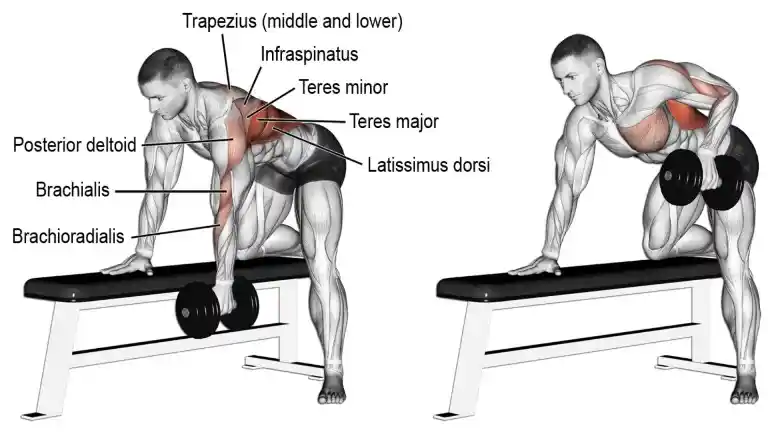
How To Do One Arm Dumbbell Row
- Begin by standing with your feet shoulder-width apart, holding a dumbbell in one hand.
- Bend your knees slightly and bend forward at the hips, keeping your back straight and parallel to the ground.
- With your other hand, brace yourself on a flat bench or the ground.
- Keeping your elbow close to your body, pull the dumbbell up towards your side, squeezing your back muscles at the top.
- Lower the dumbbell back down to the starting position, and repeat for the desired number of reps.
10. Renegade Row
The renegade row is a full-body exercise that targets the primary muscle groups of the lats, shoulders, and core while also engaging the triceps, biceps, and legs.
It is a variation of the traditional plank exercise that adds resistance by incorporating a rowing movement with dumbbells.
You can increase the intensity of this exercise by trying renegade row push up.

How To Do Renegade Row
- Take plank position with a pair of dumbbells placed on the floor underneath your shoulders.
- Engage your core and maintain a neutral spine.
- Start the exercise by lifting one dumbbell up to your chest.
- Keep your elbow close to your body.
- Lower the dumbbell back down to the starting position.
- Perform the row with your other arm, this completes one repetition.
11. Dumbbell Deadlift
The deadlift is the King of all exercises, and It is a powerful exercise designed to build an overall physique that uses more muscles than any other lat exercise.
The dumbbell deadlift is the best exercise for posterior chain muscle strengthening, which includes the lat, erector spine, glutes, and hamstrings.

How To Do Dumbbell Deadlift
- Place a dumbbell in front of you. Grab the dumbbells with each of your hands.
- Remember to keep your back as straight as possible and contract your back and hamstrings.
- Raise the dumbbell from the ground using your hamstrings and glutes.
- You should keep your legs slightly bent, back straight, and head looking up.
- Raise it to the point where your body is erect. Do not hyperextend your body as the weight shifts to the lumbar spine.
- Hold the dumbbell for a moment at the top of the lift.
- Now, lower the dumbbell slowly at a steady slow pace by bending at the hips first and then at the knees and let the weight almost touch the ground for a moment before you begin the next rep.
Know More: 10 Best Dumbbell Back Exercises To Build Mass And Strength
Exercises To Improve Back Flexibility and Strength
A flexible spine is essential for a strong back. When your spine is flexible, it can move through a full range of motion, which helps to keep your muscles and joints healthy. It also helps to reduce your risk of injury.
There are many different exercises that you can do to improve your spine flexibility. Here are some of the most effective exercises.
12. Cat Cow
The cat-cow exercise is a spinal mobilization exercise that helps a person “loosen” their spine. It improves movement of your lower back.
The Cat-Cow stretch is a gentle flow between two poses that warms the body and improves spine flexibility. It stretches the back, and neck, and softly stimulates and strengthens the abdominal organs.
This exercise also opens up the chest, encouraging the breath to become slow and deep.
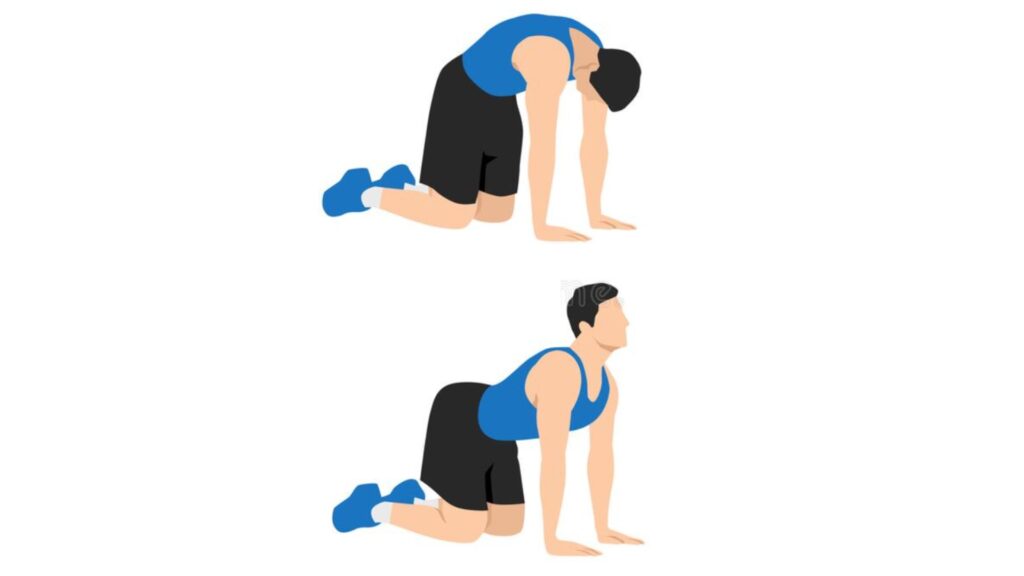
How To Do Cat Cow
- Start on your hands and knees, with your hands directly under your shoulders and your knees directly under your hips.
- As you inhale, arch your back and lift your head and tail bone towards the ceiling.
- As you exhale, round your back and tuck your chin towards your chest.
- Continue alternating between the cat and cow positions for 10-15 repetitions.
13. Knee to Chest
This is another simple yet effective workout. Knee-to-chest stretches can help elongate the lower back muscles, relieving tension and pain.
This should be performed with one knee at a time rather than two knees
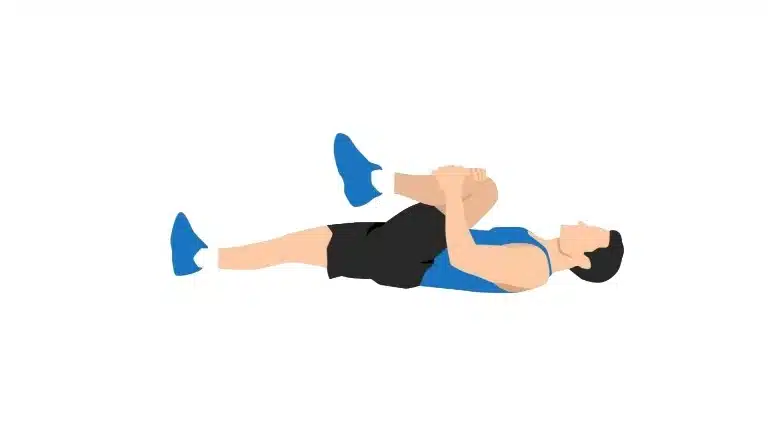
How To Do Knee to Chest
- You will simply start by laying down straight on your back.
- Now fold the knee and then gently support the knee to bring it closer to the chest.
- Return to the starting position.
- Repeat with the left leg and then return to the starting position.
14. Lying Bent-Knee Twist
The Lying Bent-Knee twist is a bodyweight exercise that strength in the obliques and back muscle.
This exercise can act as a stretch, but the main purpose is to stabilize your core and strengthen your obliques. In everyday life, your posture will benefit from this antidote to sitting and hunching overwork.

How To Do Lying Bent-Knee Twist
- Lie on your back on the floor or mat with arms extended out to the sides to keep your body stable during the exercise.
- Raise and bent legs at a 90-degree angle, so thighs are vertical and lower legs are horizontal.
- Slowly lower your legs to one side until you feel a mild stretch in your lower back.
- Now, rotate your legs all the way to the right. Repeat for the desired number of reps.
15. Abdominal Breathing Maneuver
Strong abdominal muscles help support the spine and keep the hips properly aligned. Weak abdominal muscles can lead to poor core strength, which can ultimately cause back pain.
The Abdominal Breathing Maneuver might look hard, but so far, it’s the simplest workout that builds core strength without taking a lot of effort.
Learning controlled, diaphragmatic breathing is beneficial for everyone and is also a good stress relief technique.
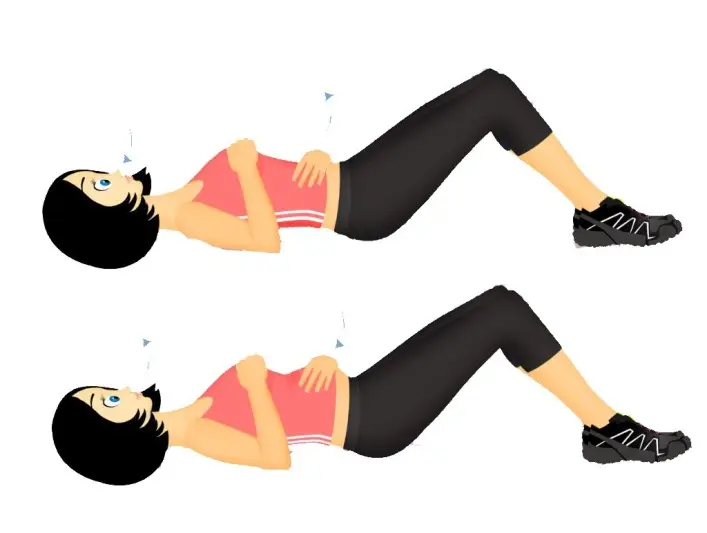
How To Do Abdominal Breathing Maneuver
- You will simply start by laying down on your back while your back is straight.
- Now, inhale the air till you feel your belly are filled with air, and you feel the tension.
- Now, hold it and when you exhale make sure to draw the belly button towards the spine.
Benefits of the Back Workout
Most people think that exercising for their back means they either have a backache or they are prone to backache.
However, limiting the scope of workouts just to cure pain is not enough.
Here are some of the other reasons you need to work on your back:
- Helps you get into shape
- Improve the strength of your back
- Improves the stability of the backbone
- Build lean muscle
- Prevents injury and pain
- Boosts quality of life
- Make movement effortless and painless
- Improves posture
- Makes you look better
Conclusion
To sum it all up, it all comes down to the way you plan your workout. Most people focus on just one basic workout that either helps them in strengthening their back or just helps them with flexibility.
However, you need a workout plan that addresses all your concerns and still helps you perform your daily tasks effortlessly.
To start exercising you don’t have to wait for backache or get old, instead if you start at a young age, there is a high chance that you will be able to help your body adjust.
This will also help in improving mobility, helping you lift painlessly, and also it will boost your overall quality of life.
References
- James Rainville, Carol Hartigan, Eugenio Martinez, Janet Limke, Cristin Jouve, Mark Finno: Exercise as a treatment for chronic low back pain. PMID: 14749199 DOI: 10.1016/s1529-9430(03)00174-8
- A Murtezani, H Hundozi, N Orovcanec, S Sllamniku, T Osmani: A comparison of high intensity aerobic exercise and passive modalities for the treatment of workers with chronic low back pain: a randomized, controlled trial: PMID: 21602759
- Rahman Shiri, David Coggon: Exercise for the Prevention of Low Back Pain: Systematic Review and Meta-Analysis of Controlled Trials: American Journal of Epidemiology.
- Suh, Jee Hyun MD; Kim, Hayoung BS; Jung, Gwang Pyo MD; Ko, Jin Young MD; Ryu, Ju Seok MD, PhD: The effect of lumbar stabilization and walking exercises on chronic low back pain.
- Manniche C, Lundberg E, Christensen I, et al. Intensive dynamic back exercises for chronic low back pain: a clinical trial. Pain 1991;47:53–63.
- Hartigan C. Exercise-based therapy for low back pain. https://www.uptodate.com/contents/search. Accessed April 19, 2023.
- Spine conditioning program. American Academy of Orthopaedic Surgeons. https://orthoinfo.aaos.org/en/recovery/spine-conditioning-program/. Accessed April 19, 2023.
Disclaimer
This article provides general information about back strengthening exercises. It is not a substitute for professional medical advice. Consult your doctor before starting any new exercise program, especially if you have any health conditions. Only perform exercises after getting clearance from your doctor and stop if you feel pain. The author is not liable for any injuries resulting from the exercises in this article.

Manish brings over 10 years of hands-on experience in weight lifting and fat loss to fitness coaching. He specializes in gym-based training and has a lot of knowledge about exercise, lifting technique, biomechanics, and more.
Through “Fit Life Regime,” he generously shares the insights he’s gained over a decade in the field. His goal is to equip others with the knowledge to start their own fitness journey.
